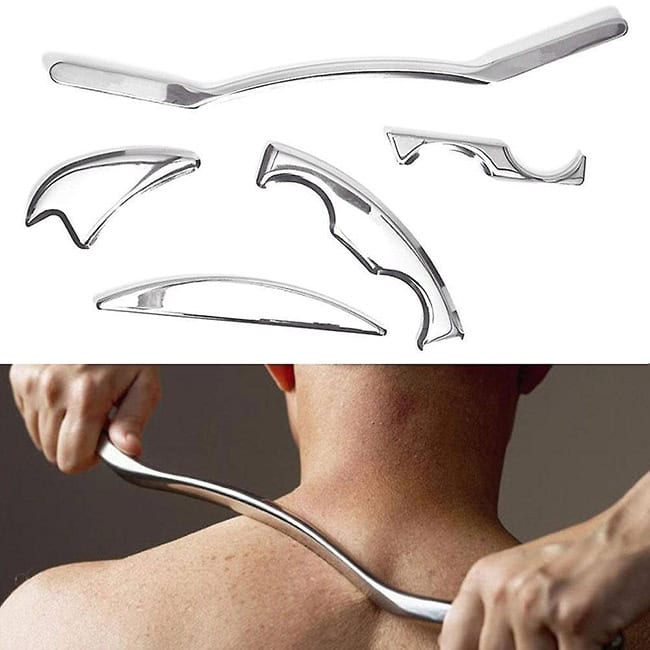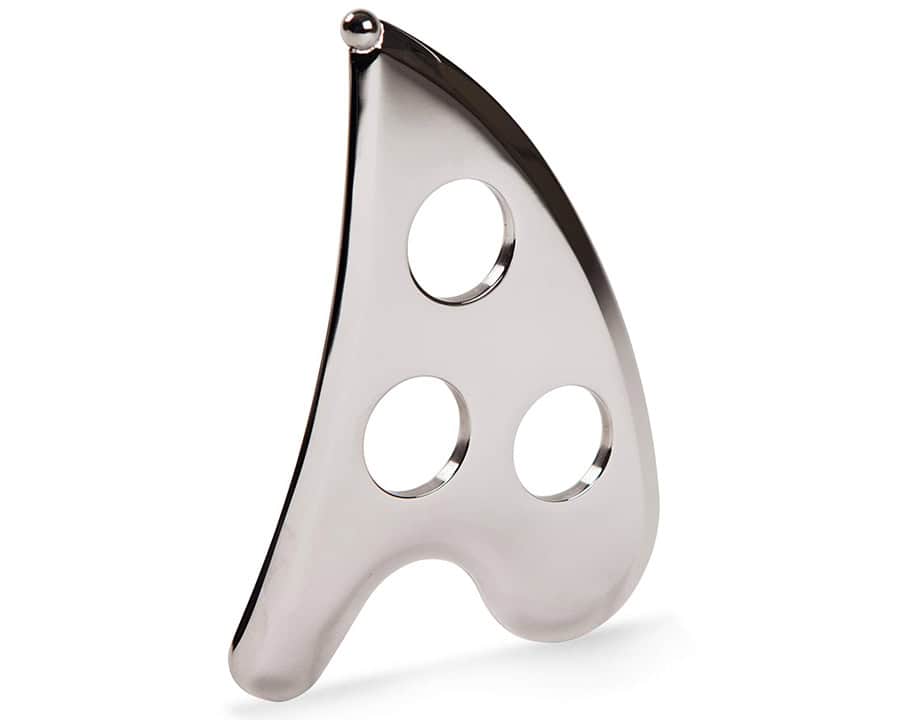Myofascial release tools are commonly used as part of myofascial release therapy. These are physical therapy tools that target the connective tissue, known as fascia, that wraps around muscles, organs, and everything else in our bodies. If you suffer from chronic pain, limited mobility, or post-injury stiffness, this hands-on approach using myofascial release tools to healing can be transformative and truly life-changing.
Plus, with the rise of innovative tools and technological advancements that we can now use during sessions, myofascial release therapy is really revolutionizing pain management and total-body well-being. Let’s take a look at some of the benefits of Myofascial release.

What Is Myofascial Release Therapy And What Are The Benefits?
The allure of Myofascial Release lies in its non-invasive nature and holistic approach to treating pain. By targeting the fascia, we address the body’s interconnected system rather than isolated symptoms. Before deep diving into the tools and technologies that can enhance this therapeutic method, it’s essential to understand the foundational elements of Myofascial Release Therapy.
Fascia is a thin but tough, elastic-like tissue that wraps around most structures within the human body, including muscle. Over time, fibrous fascia can become constricted due to overuse, trauma, infectious agents, or inactivity, resulting in pain, muscle tension, and corresponding diminished blood flow.
Myofascial Release Therapy is traditionally a hands-on technique involving a therapist applying gentle, sustained pressure into connective tissue trigger points and restrictions to remove pain and restore movement and mobility.
“Myofascial” comes from “myo, ” which means muscle, and “fascia, ” which refers to the connective tissue. Myofascial therapy and the tools they use, center on treating fascial tension and imbalances, unlike massage, which often focuses on relaxation and relief of muscle discomfort.
During sessions, we use a range of movements and pressures, including elongating the fascia, to release adhesions and tightness. We perform the techniques using our hands, forearms, elbows, or specialized MFR tools.
One of the main benefits of this type of therapy is relief from pain and soreness. The gentle pressure during the sessions soothes tight and sore muscles and reduces stress levels. Reducing muscle tightness and stress promotes total-body wellness, improves sleep quality, and promotes a positive mental state.
By easing the tension in the fascial tissues, pressure on pain-sensitive structures like nerves and vessels is relieved, reducing chronic pain, particularly in conditions like fibromyalgia, back pain, and after injury. Myofascial release also helps to restore optimal length-tension relationships to our muscles and fascial networks, increasing joint range of motion and overall flexibility.
This improvement can enhance performance in physical activities and decrease the likelihood of injury. The relaxation of tight tissues during myofascial release also stimulates blood flow and lymphatic fluids in the body. Better circulation leads to faster recovery from workouts and reduced swelling or edema.
Myofascial Release Therapy can also correct musculoskeletal imbalances. Over time, our bodies can develop patterns of compensation that may lead to structural misalignments. Myofascial release helps to correct these imbalances by releasing the uneven tightness in injured fasciae that may pull the body out of alignment.
Going even deeper, myofascial release promotes the smooth functioning of cells and surrounding tissue by releasing fascial tension, allowing the body to operate more efficiently with better cellular nutrition and waste removal.
For some people, physical tension in the fascial tissues may link to emotional stress. So, myofascial release can sometimes aid in emotional release, providing a feeling of renewal and emotional balance on top of the physical benefits of the therapy.
Its capacity to ease pain, restore motion, and support the body’s ability to heal makes it a sought-after therapy by athletes, people recovering from injuries, and anyone looking to maintain a healthy and balanced body, especially if you’re dealing with persistent pain or mobility issues.
More Blogs From Release Works
Why Neck Surgery/Back Surgery Can Actually Make Things Worse
5 Easy Exercises To Help With Frozen Shoulder Release
Myofascial Release Therapy can help with:
- Chronic Back Pain: Many people wrestle with chronic back pain, often turning to medication for temporary relief. Myofascial release can address the underlying fascial constrictions that contribute to the persistence of back pain. We ease the tension and promote pain relief by targeting the fascia, specifically around the spine and lower back.
- Fibromyalgia: Fibromyalgia isn’t a disease. It’s a set of symptoms characterized by widespread musculoskeletal pain, fatigue, and tenderness. It’s thought to amplify painful sensations by affecting how your brain processes pain signals. Myofascial release can play a role in managing symptoms by reducing fascial tightness and alleviating the compression and nervous system dysfunction that contributes to discomfort and pain.
- Temporomandibular Joint Disorder (TMJ): TMJ disorders cause pain and discomfort in and around the muscles that control joint movement and the jaw joint. Myofascial release can help with TMJ by addressing the tightened fascia around the jaw and the muscles involved in mastication, contributing to jaw restriction and pain.
- Carpal Tunnel Syndrome: Carpal Tunnel Syndrome—the compressing of the median nerve that runs through the “carpal tunnel” of the wrist—is another condition that can benefit from myofascial release therapy by easing the pressure within the tunnel and alleviating the symptoms.
- Migraines and Headaches: While migraines and headaches can stem from various causes, the tension in the fascial tissues in the head, neck, and shoulders is often a contributing factor. Myofascial release therapy relieves this tension and can be a part of a comprehensive approach to managing headache-related pain.
- Post-Surgical Scar Tissue: Following surgery, scar tissue can form and lead to stiffness and functional limitations. Myofascial release therapy can assist in stretching and remodeling the scar tissue, which can help enhance movement and reduce discomfort.
Tools That Enhance Myofascial Release Techniques
Traditionally, myofascial release therapists rely on their hands as the primary instrument for myofascial release. However, alongside these skilled manual techniques, a variety of specialized tools offer unique advantages to accentuate the benefits of myofascial release therapy. They include:
- Foam Rollers: Foam rollers are the most recognized tool for myofascial release. They provide a versatile approach to addressing large areas of fascia and muscle. Regular myofascial release sessions with a foam roller can increase flexibility, function, and performance while reducing inflammation and muscle soreness.
- Myofascial Release Balls: Balls of various sizes and densities, such as tennis balls or lacrosse balls, can target more specific points that are difficult to address with foam rollers. These are excellent for isolated pressure and deep tissue stimulation, emulating the precision of a therapist’s elbow or thumb.
- The FasciaBlaster: A relatively novel entrant in the market for self-myofascial release, this tool claims to reduce cellulite by targeting fascial adhesions and promoting increased blood flow. The device consists of a hard plastic stick with little claws that massage the fascia, designed to mimic the complex movements of a therapist’s hand.
 Technological Integration in Myofascial Release
Technological Integration in Myofascial Release
We get incredible results from the hands-on therapy alone. Still, introducing technology into myofascial release therapy sessions has elevated the practice to new heights, making the therapy even more effective and precise. Those technologies are:
- Ultrasound Therapy: High-frequency sound waves used in ultrasound therapy help to warm the fascia and muscles before manual therapy, enabling deeper penetration and a more effective release. This tool helps to relieve pain, reduce inflammation, and increase blood flow.
- Electronic Fascial Mobilization Devices: These battery-operated devices oscillate at various frequencies to assist muscle recovery, decrease pain, and improve mobility. With adjustable intensities, we can cater to individual needs and sensitivity levels.
- Pressure Biofeedback Devices: Pressure sensors provide instant feedback about the force applied to enhance the efficacy of traditional myofascial release techniques. This technology helps refine our pressure application during sessions and ensures patient safety.
- Infrared Light Therapy: By emitting specific wavelengths of light, infrared therapy devices stimulate cellular repair and increase circulation, facilitating the myofascial release process. This non-invasive approach can penetrate deeper layers of tissue and assist in healing.
- AI and Myofascial Mapping: One of the most exciting developments in this field is the exploration of artificial intelligence and myofascial mapping. With AI-powered algorithms, we can potentially diagnose fascial tightness patterns more accurately, creating personalized treatment plans that are more effective than ever. Integrating 3D body scanning technologies generates comprehensive visual maps of the fascia, allowing us to pinpoint the exact locations of disruptions. These digital maps can track progress over time and enable adaptions to the treatment protocol.
The Future Of Myofascial Release Therapy
Modern myofascial release therapy juxtaposes the timeless value of human touch with the precision of modern tools and technology. By embracing both, we are better equipped to diagnose soft tissue dysfunctions, customize therapeutic interventions, and monitor rehabilitation progress with unparalleled accuracy.
New tools and technologies enhance the therapeutic experience and empower our patients to participate actively in their healing journey, from the convenience of foam rollers for maintenance between sessions to clinically proven technological devices.
As research advances and the understanding of fascial health deepens, the commitment to integrating cutting-edge technologies into rehabilitative care practices promises an optimistic future for patients and therapists alike.
Whether you are a healthcare professional or an individual seeking relief and recovery, staying informed about the tools and technology available can make a significant difference in your pursuit of health and wellness. Remember, while technology paves new roads in therapy, the human element remains the beating heart of healing.
In myofascial release therapy, hands are not replaced—they are extended, enhanced, and empowered through tools and technology designed to unlock the full potential of therapeutic touch.

